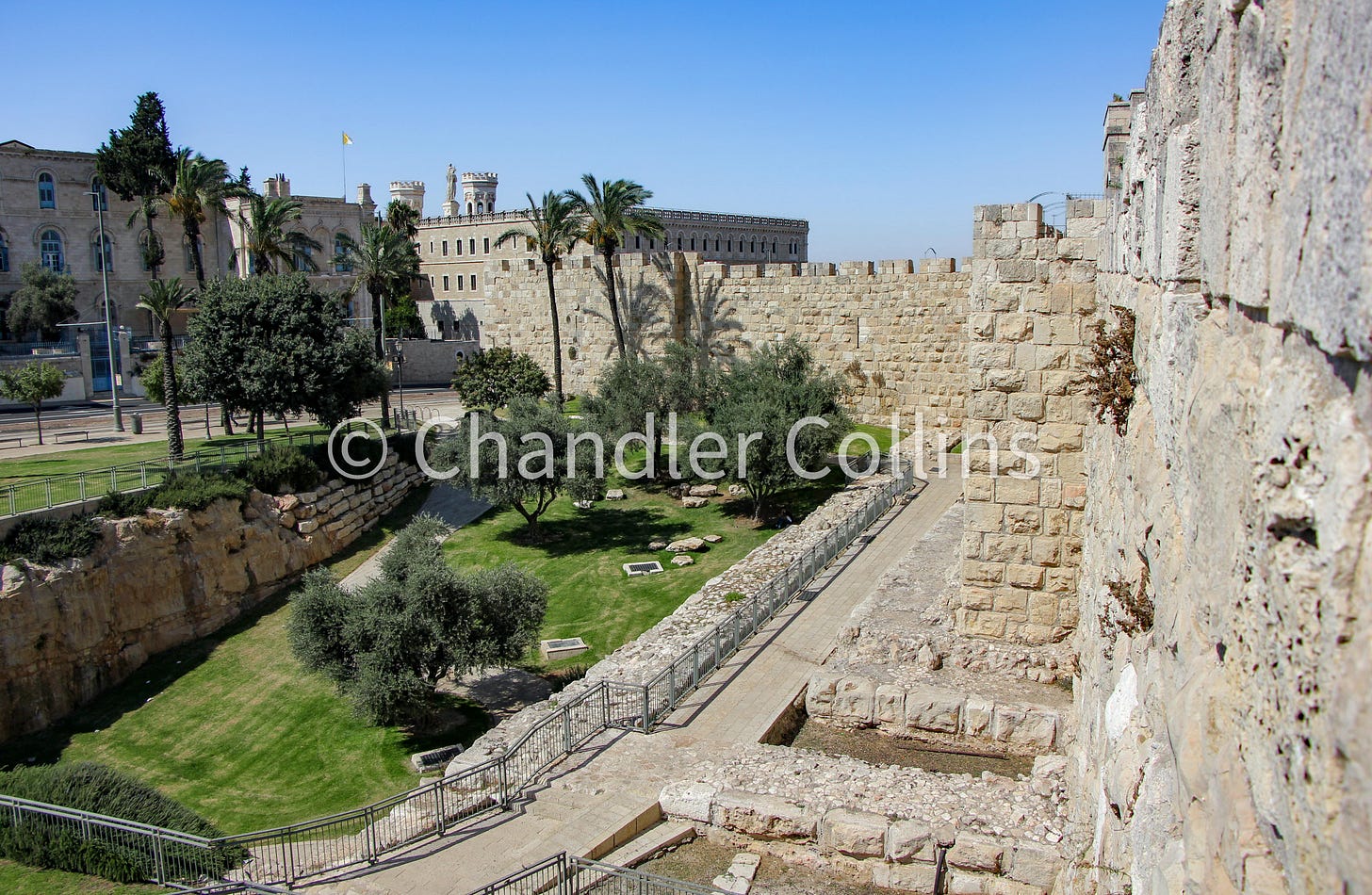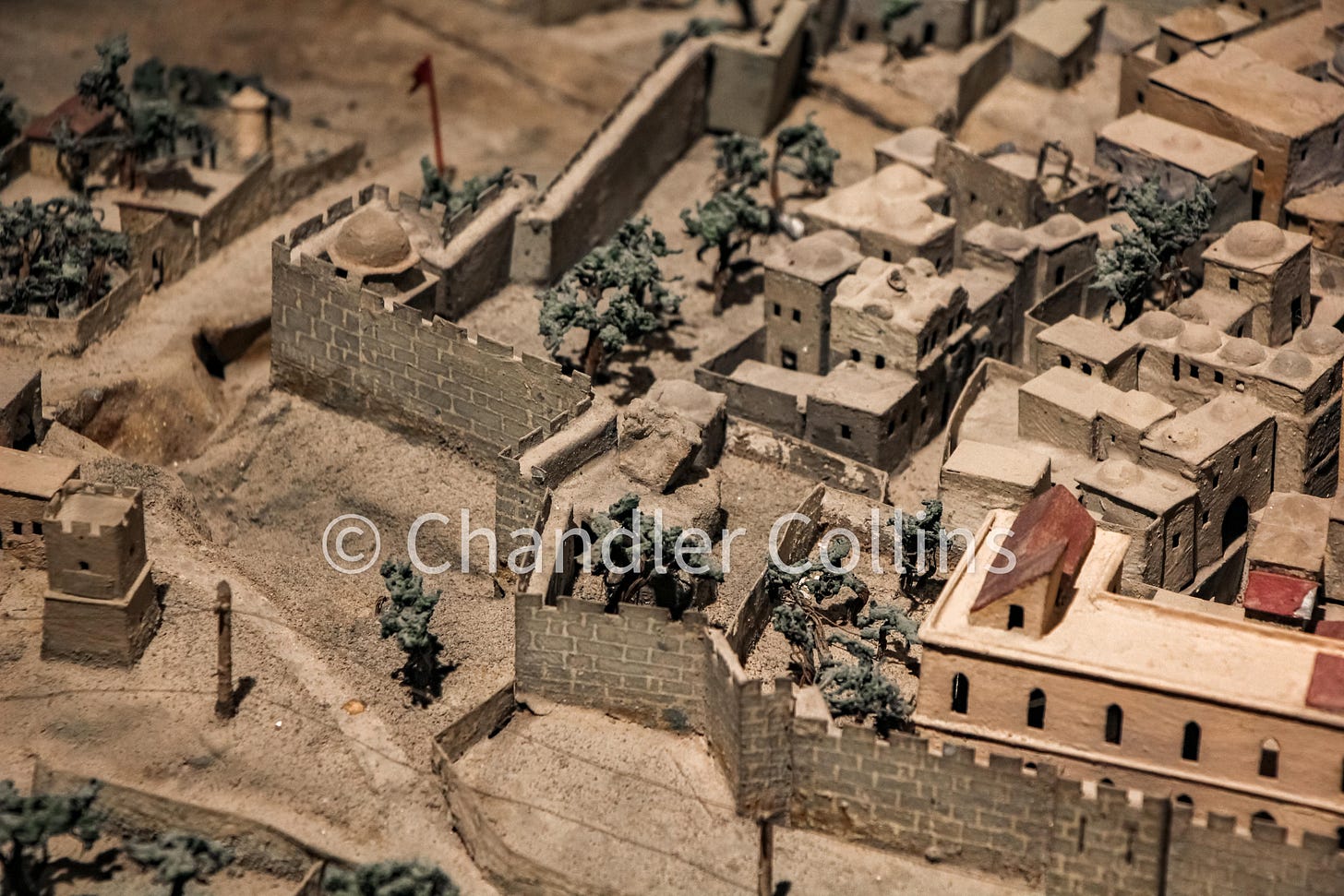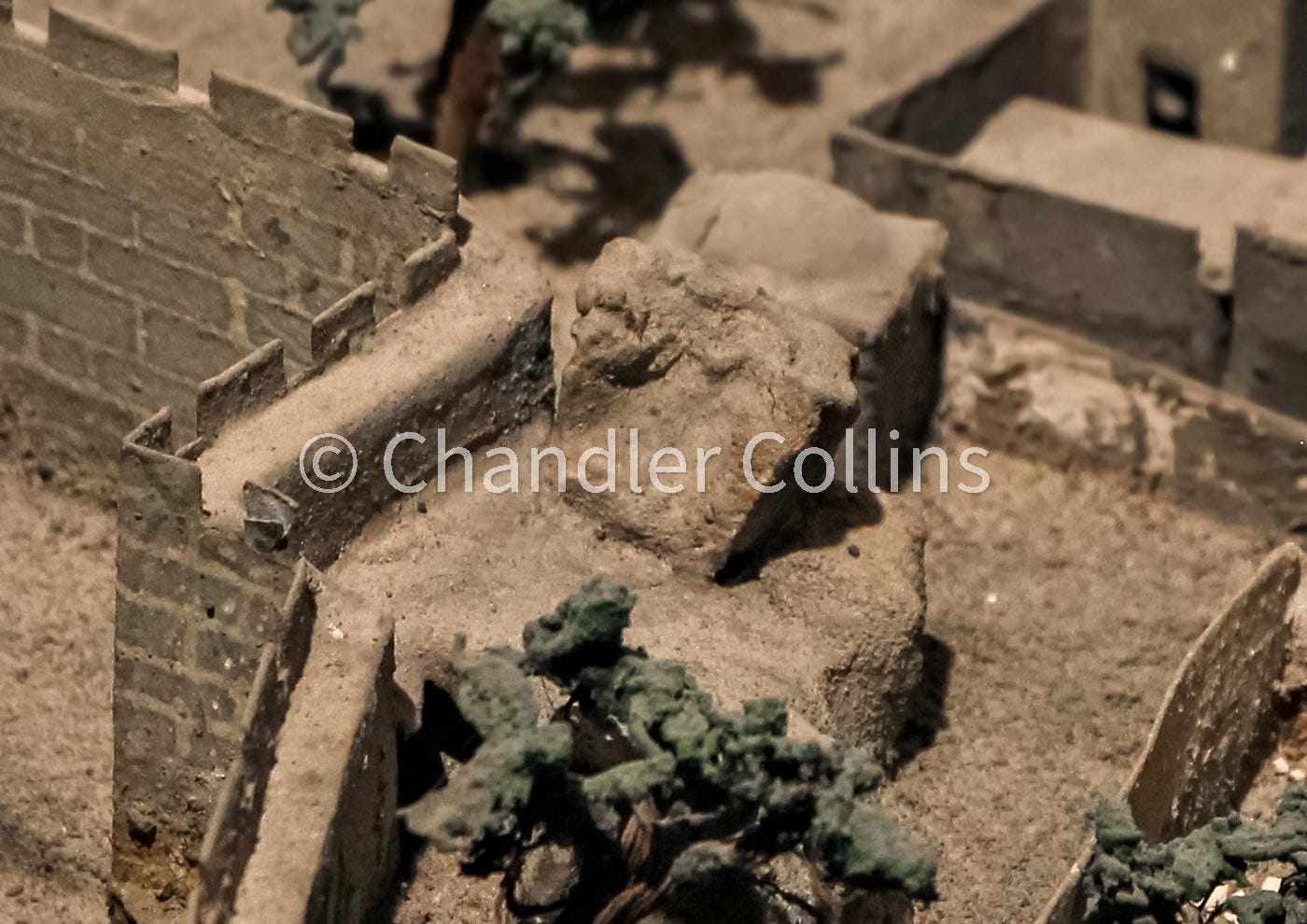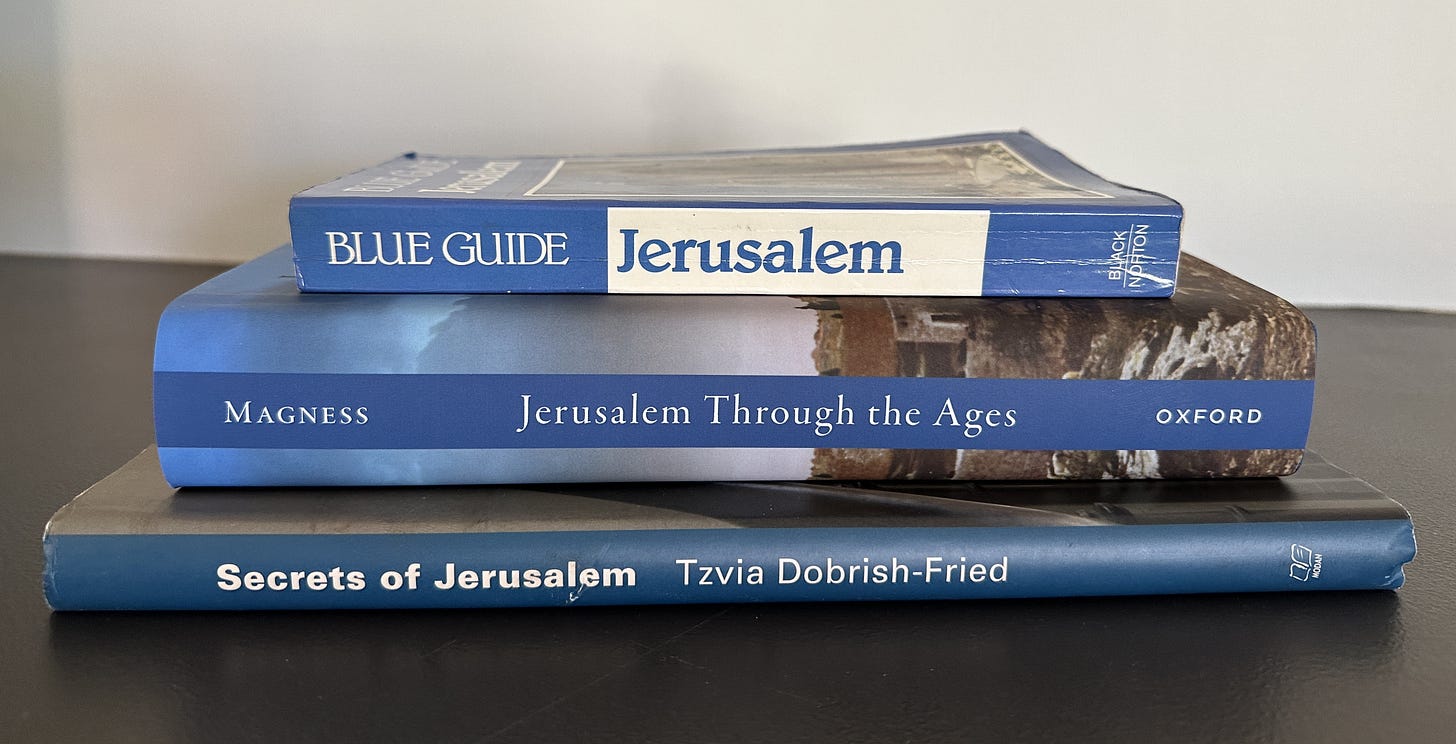Jerusalem in Brief (No. 3)
A tower named after a Philistine giant, some new books, and a dinner party in the middle of World War I
If you find this newsletter valuable, consider upgrading to a paid subscription and receive unique Jerusalem-related benefits.
I’m happy to bring you the third edition of Jerusalem in Brief. For new readers, I publish this series on the second Friday of every month. It usually includes summaries of new and interesting studies on historical Jerusalem and provides a space to point out some fun resources and anecdotes. I generally write longer and more in-depth posts about one issue on the last Friday of each month. In today’s edition, we’ll look at part of a 19th-century model of Jerusalem, preview some books, and explore an anecdote from the Spanish consul in Jerusalem during World War I.
Jerusalem visualized
Among the many models of Jerusalem created in the 19th century, that of Stefan Illés stands out for its remarkable detail and depiction of the Ottoman (rather than biblical or historical) city. Once complete, the model toured European cities, including a stop at the 1873 World’s Fair in Vienna where it was displayed in the Ottoman Pavilion (Rubin 2007:74). Owned by the citizens of Geneva, the Ilés model has been on loan to the Tower of David Museum since 1984. For many years it was displayed in a remote corner of the museum on the basement level, but it was recently moved to one of the freshly renovated main galleries where it is the subject of a new interactive display.
The photo above shows once small section of the Illés model, highlighting the area near the northwest corner of the city wall. Jaffa Road runs along the foot of the wall, and a small tower on the left guards the open road between the Russian Compound and beginning of the Ottoman fortifications. The city’s telegraph line, which entered Jerusalem at Jaffa Gate, can be seen at the bottom of the photo, and the Latin Patriarchate building stands on the far right. New Gate would not been constructed until 1887 after a need arose for residents and pilgrims outside the wall to enter the city in this area.
A ditch visible on the model to the north of the city wall (far left) has been since filled in. Route 60 and the rail tracks run over that area today. The ditch was originally part of a system of medieval trenches on the north side of Jerusalem that protected the city’s historical weak point. Some related artificial scarping is visible between Damascus Gate and Herod’s Gate on which the Ottoman wall was constructed. Another section of the trench system was recently uncovered there that made headlines due to a mysterious handprint found within it. Another piece of the trench quite clearly separates the northeast corner of the Old City wall from the plateau to its north on which the Rockefeller/Palestine Archaeological Museum stands today.
An interesting monument stands out in the center of this photo that was known locally in Arabic as Qal’at Jalud/ṭ (Goliath’s Castle). This name apparently echoes a medieval tradition that placed the battle between David and Goliath in this location, quite far from the Elah Valley where I Samuel 17 locates it (Bahat and Ben-Ari in Yadin (ed) 1976:109). If this understanding is correct, it reflects one of many historical memories related to King David that gravitated toward the Western Hill, which was once assumed to be the ancient core of Jerusalem (one visitor who took this view even mourned its current state). The monument also became known as Tancred’s Tower after the Crusader and his company besieged this section of the fortifications during the First Crusade in 1099 CE.
The tower’s appearance on the model, in contemporary photos, and in 19th-century descriptions shows that its surviving superstructure was made mostly of dirt, field stones, and other rubble material. However, excavations revealed several large stone piers buried below that are not visible on the model. They consisted of rectangular dressed stones similar to others found throughout Jerusalem in the city walls and Tower of David, for example. These piers were incorporated into the lower level of the Collège des Frères, which was built on the spot in the late 1870s (Hoade 1962:320). They are apparently still visible today, but I’ve not yet been able to visit them.

The ruins of this storied landmark once inspired scholarly conversations about the location of the Third Wall. According to Josephus’s famous account in book five of The Jewish War, Herod Agrippa I began to construct the Third Wall during his reign in order to fortify new northern suburbs but abandoned the project after laying only the foundational courses. It was quickly finished at the beginning of the Jewish Revolt in 66-67 CE in preparation for the Roman assault. Josephus also describes an octagonal tower named Psephinus which he says was set into the northwest corner of the Third Wall and allowed a view to the Mediterranean Sea and Arabia.
During the 19th century, a few scholars identified the superstructure of Goliath’s Castle with Psephinus. Others believed that the stone piers encased beneath Goliath’s Castle, with masonry resembling other Herodian projects, might be remains of the octagonal tower. Either view assumed that the location marked the northwest corner of the Third Wall, which would then logically have run eastward on the same line as the northern line of the Ottoman city wall.
It would be fascinating to explore the long history of the debate on the Third Wall, and perhaps that can be done in another post. Suffice it to say that nearly all scholars today locate the Third Wall much further north and would place the tower Psephinus somewhere on or near the Russian Compound Plateau. Illés’s careful attention to detail transports us back to a time when debate about the Third Wall was driven in part by a small ruined tower visible on the northwest corner of the Ottoman city.
New (and old) arrivals
Of the buying and reading of books about Jerusalem, there is no end. I recently received my copy of Jodi Magness’s new book Jerusalem Through the Ages, which I have been anticipating for several years. The book offers an updated discussion of the city’s archaeology and surveys ten major periods of its history from the Bronze Ages through the time of the Crusaders. I’m looking forward to reading it and suspect it will serve as a good introduction to Jerusalem’s geography, archaeology, and history.
The other books are used but new to me. Kay Prag’s 1989 Blue Guide to Jerusalem will have certain aspects that are out of date, but it is a very detailed archaeological guidebook with information on a wide number of sites in the city all in one place. Secrets of Jerusalem (2007) by Tziva Dobrish-Fried highlights 43 sites accompanied by original photographs of Uriel Messa. Some are more well-known than others (e.g. the roof of the Holy Sepulcher or Jason’s Tomb), but I suspect anyone who picks up this book will add at least a handful of new sites to their Jerusalem bucket list, just as I did.
Notes & quotes
Conde de Ballobar was the Spanish consul in Jerusalem from 1913 to 1919. Owing to Spain’s neutral status during World War I, he had the unique experience of being the only foreign consul allowed to remain in the city during that time. He kept a dairy which was first published its original Spanish and translated into English in 2011 as Jerusalem in World War I. The Palestine Diary of a European Diplomat (edited by Eduardo Manzano Moreno and Roberto Mazza). Mazza also provides a helpful introduction and notes.
There are a number of interesting details and anecdotes throughout the book. The entry for 9 July, 1916 recalls a dinner party at the residence of the Spanish consul. A group of people, including Djemel Pasha (of the triumvirate ruling the Ottoman Empire at the time), were invited. I found Ballobar’s description of the evening’s dinner and activities striking given the economic hardship suffered in Jerusalem during World War I:
“It was not a war-time menu, since it was composed of Turkish soup, fish in mayonnaise sauce, garden-style filets, Spanish cookies and stuffed turkey. For desserts, vanilla ice cream, frozen pineapple and fruit. As for the drinks, the wine cellar of the director of the Crédit Lyonnais provided them, and they consisted of St. Julien, Rhin (Sauternes Chateau La Tour Blanche) and Atler champaign. The meal went by in very animated fashion, above all with jokes as always about our Greek colleague. As if that weren’t enough, the cigars were first rate and, after getting some fresh air on the balcony, we played a poker game that lasted until 1:00 in the morning.” (Ballobar 2011:103)
Internet standouts
G. J. Wightman’s important study The Walls of Jerusalem: From the Canaanites to the Mamluks is now available free for digital borrowing on archive dot org. This is one of many “ghost books” on Jerusalem, available in selected university libraries and virtually nowhere else. The volume is out of print, and you will be hard pressed to find even used copies available for purchase. How nice to see it made widely available.
Paid supporters
Thanks to all who attended the livestream this past Tuesday night. I sent a link to the recording via email for those who couldn’t make it. The next one will take place on June 25 from 8:00-9:30pm, and you will receive a link beforehand.
Milestones
I’m grateful to report that this newsletter recently surpassed 500 subscribers. A heartfelt thanks to every one of you and especially to those who have shared and supported the effort.
Enjoy this post?
Show your appreciation by leaving a tip as low as the price of a cup of coffee. Less than 1% of readers do this, and it makes an enormous difference.
Follow Approaching Jerusalem
View the newsletter archive and follow Approaching Jerusalem on social media for archaeological stories, upcoming lectures, and other Jerusalem-related news, resources, and analysis.




